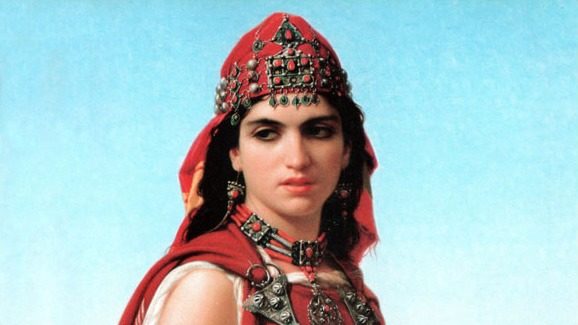[dropcap]I[/dropcap]n the seventh century CE, an Arab army swept across North Africa with the goal of conquest, only to be defeated by a female warrior who led the resistance against their military advances. Commonly referred to as the “Kahina,” meaning “seer” in Arabic, this brave and defiant woman belonged to a Judaized Berber tribe in the Aurès Mountains of modern Algeria. Also known by the proper name of Dihya, she led the Berber resistance against the advancing Arabs, pushing them eastward beyond the borders of modern Libya. A few years later, a reinforced army of Arabs invaded again, pursuing Dihya into the mountains, killing her in combat in 702 CE near a well that has been named biʾr al-Kāhina, or “well of the Kahina” in her memory.
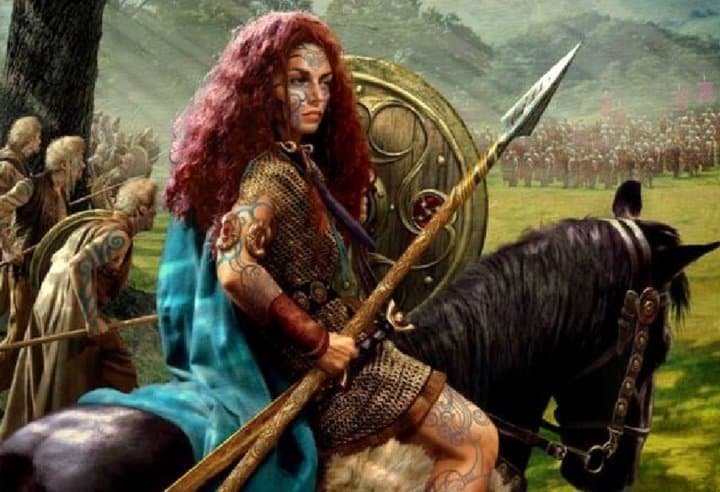
This account comes from Hsain Ilahiane’s Historical Dictionary of the Berbers (Amazigh People) and is one of many that tells the story of the Dihya. Since the ninth century, accounts of the Dihya have been adopted, transformed, and rewritten by various social and political groups in order to advance such diverse causes as Arab nationalism, Amazigh-Berber ethnic rights, Zionism, and feminism.
Throughout history, Arabs, Berbers, Muslims, Jews, and French colonial writers, from the medieval historian Ibn Khaldūn to the modern Algerian writer Kateb Yacine, rewrote the legend of the Dihya, and, in the process, voiced their own vision of North Africa’s history. Arabs apparently referred to her as the “Kahina” because of her supernatural powers or to discredit her as a sorcerer, and some Arab historians advanced the story that Dihya at first opposed Islam but eventually asked her sons to adopt this new religion in order to demonstrate the inherent unity between Arabs and Berbers.
During the colonial period, the French historian and politician Ernest Mercier recounted a version of the Dihya’s battle to legitimize French colonization, framing it as the liberation of Berbers from their Arab oppressors. Some recount that the Dihya was from a Jewish tribe, while others state that she was Christian, or even pagan. The ever-changing story of the Dihya, therefore, allows different groups to express their political aspirations.
The account of the Dihya given in Hsain Ilahiane’s Berber dictionary can be framed in terms of the post-colonial Berber struggle against Arab-Islamic hegemony. The Historical Dictionary of the Berbers attempts to bring recognition to Berbers, who feel that their distinct culture and language have been marginalized and their history left out of official accounts given by their national governments. Ilahiane wrote that the Dihya was from a Jewish tribe, giving voice to the history of friendship and mutual respect that Berber activists believe existed between Berbers and Jews who have lived in North Africa since at least 70 CE, possibly even earlier.
[ads2]
Dihya has become such a popular figure among Berber-Amazigh activists across northern Africa that a statue memorializing her was erected in Algeria; people also post images of her on Berber activist websites and paint them as graffiti. Although little is known about her as an actual historical personage, Berber political and cultural activists have adopted certain visual tropes that, when deconstructed, reveal the political and social agenda of a liberal-oriented transnational Berber movement that emphasizes gender equality as well as religious and ethnic tolerance. Dihya symbolizes Berbers as a people who refuse to be subjugated, free and willing to fight to retain their freedom against outside invasion.
Over the last several decades a transnational activist movement has developed to fight for the political rights of the Berber population. As the indigenous people of North Africa, Berber activists have been struggling for ethnic and linguistic recognition from their national governments, who declared themselves Arab-Islamic states with Arabic as the official language after colonial independence, even though Amazigh speakers account for approximately 40 percent of the population in Morocco and 25 percent in Algeria. They seek to make their native language, Tamazight, an official language equal to Arabic and to restructure national economic and social policies that tend to ignore Amazigh-Berber areas.
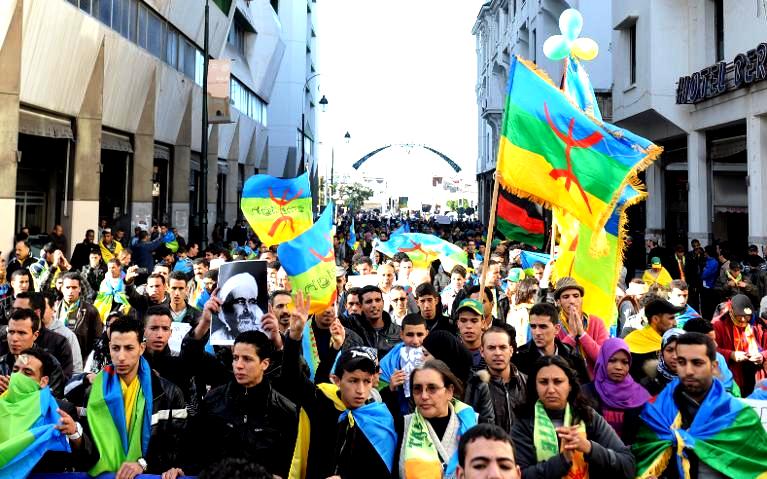
Many reject the term Berber as a pejorative label given to them by outsiders, from the Greek and Roman words for “barbarians,” preferring the term “Imazighen,” which means “the free people,” or “Amazigh,” which is the singular adjectival form. Among the various Amazigh communities in North Africa, the Kabyle region of Algeria has been among the most political, often engaging in violent confrontations with the national government. Here in this region, people name their daughters Kahina, and images of what people imagine her to have looked like serve as a visible symbols of resistance, self-determination, and freedom.
During a visit to the Kabyle region in 2006, I photographed graffiti painted on a town’s whitewashed walls that featured various historical figures adopted by the Amazigh movement. Busts of three figures done by an unidentified graffiti artist included a woman on the left of a geometric design and two men on its right. Underneath each bust was a name written in Tifinagh, an ancient Berber script dating back to the fourth century BCE that was used to write administrative texts and funerary inscriptions across northern Africa prior to use of Arabic. Amazigh activists use individual Tifinagh letters as identity markers, writing slogans on public spaces, and, in this case, a graffiti artist wrote the word “Dihya” underneath this female figure referring to the Kahina’s actual name.
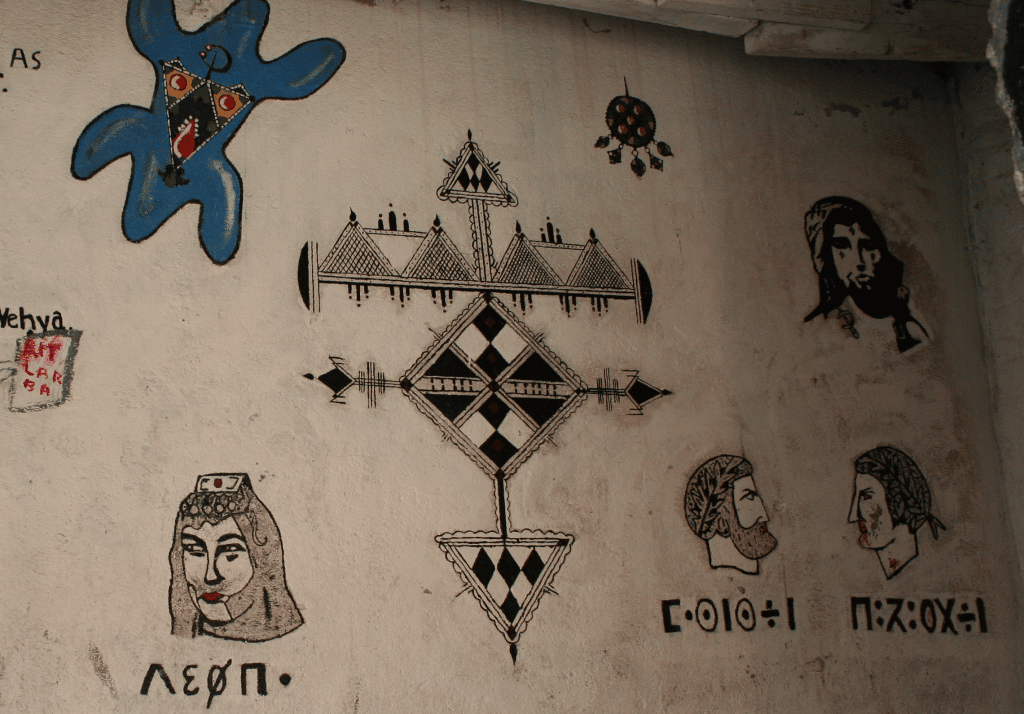
Upon closer look, the sketch of the Kahina on the wall of the Kabyle village probably derives from an 1870 painting by the French orientalist artist Charles-Émile-Hippolyte Lecomte-Vernet. Although the current location and original title of the painting by Lecomte-Vernet is unknown, his painting of a female figure, known by the current title Berber Woman, has been reproduced on dozens of Amazigh websites and blogs to represent the mythological figure of Dihya. The artist painted Dihya on the wall near two male figures, including a bearded King Massinissa and his illegitimate grandson Jugurtha. Massinissa ruled an ancient North African kingdom called Numidia as an ally of Rome from 206 BCE until his death in 148. Under Massinissa, Numidia extended from the contemporary nation of Morocco in the west to eastern Libya. Jugurtha boldly usurped the throne from Massinissa’s legitimate heirs, taking power around 117 BCE and waging war against the Roman Empire for eight years. Eventually Jugurtha was captured, brought to Rome in chains, and executed in 104 BCE.
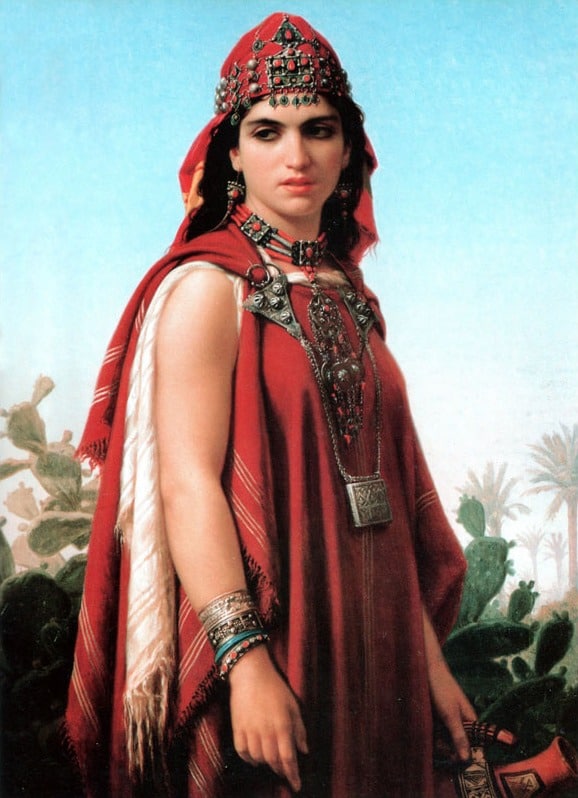
Painted in the hyperrealist style typical of nineteenth-century orientalist art, Lecomte-Vernet painted the bare arm of this female figure to exude a sense of strength, while her sidelong glancesuggests that she is assessing a threat–a glance also captured by the graffiti artist. Her red garment suggests courage and sacrifice, while she wears Berber-style jewelry, including a silver headpiece, brooches (fibulae), and silver bracelets. The desert background suggests the geographic setting of northern Africa, yet it is removed enough from any particular historical or social context that Amazigh activists can use this painting to illustrate the story of this powerful female warrior, to whom activists commonly refer as the “Berber Queen.”
Amazigh activists view Dihya, Massinissa, and Jugurtha as seminal historical figures in order to demonstrate that Berbers have a deep history in the region prior to the arrival of the Arabs. Many embrace the Jewish origins of the Kahina to emphasize the pre-colonial rapport that existed between Muslim and Jewish Berber-speakers. Furthermore, these figures give Berbers a sense of agency and reinforce the idea of rebellion and opposition against external oppression. Jugurtha and the Kahina, especially, represent fearlessness and resistance against oppression, glorifying them to further the Amazigh movement’s contemporary political goals. The representation of a female warrior serves to further the assertion made by Amazigh activists that prior to the arrival of Arabs, North African women enjoyed greater freedom and status than they do today.
Numerous scholars have written about how nineteenth-century European paintings, such as the one by Emile Lecomte-Vernet, reveal orientalist stereotypes and reflect colonial ideologies. However, further layers of meaning enable the Imazighen to reclaim these images as a new, empowering discourse, granting them a postcolonial afterlife. Such imagery influences the performance of identity, especially gender roles, and contributes to a prevailing idea held by Amazigh activists that boldness, bravery, and the ability to serve as political leaders characterized Berber women in the pre-Islamic past.
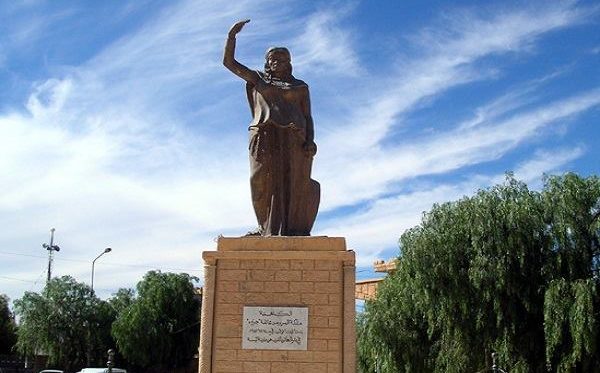
The question remains, however, whether the Dihya was an actual historical figure who attempted to resist Arab incursion. In the Algerian town of Baghaï, in the Aurès region of Algeria, activists have encouraged the government to preserve the ruins of a fortress they attribute to the Dihya, claiming that she erected it to oppose the advancing Muslim army. In 2003, L’Association Aurès El-Kahina erected an approximately nine-foot tall statue of Dihya in the center the town of Baghaï to further their connection to this legendary heroine.
Designed by a graduate of the École Nationale des Beaux-Arts in Algiers, the column-like statue features a woman wearing a sleeveless, draped garment with a single bracelet-clad arm raised in the air, a gesture associated with defiance. Her garment clings to her chest and revealing a sturdy female form and her arching eyebrows give her a stern, defiant expression. The president of Algeria, Abdelaziz Bouteflika, attended the statue’s public commemoration to appease local Amazigh activists, but, at the same time, the national press ignored the ceremony, apparently at the instructions of the government.
The national government had granted permission for the erecting of the monument, but this did not prevent its public condemnation by some. For example, the President of the Defense of the Arab Language, Othmane Saadi, asserted that the statue’s construction was an act of blasphemy, since according to the contemporary Amazigh version of the Dihya’s story, she fought to prevent the spread of Islam into northern Africa.
Like all vibrant, living ethnic movements, the Amazigh movement creates and uses images of a pre-Islamic female warrior to suggest an alternative history that exists outside of the Arab-Islamic hegemony promoted by their national governments. Imazighen across Tamazgha-northern Africa feature such images on Amazigh-centric websites dedicated to their cause and artists paint images of the Dihya complete with a fierce expression of defiance. Dihya has crossed the Atlantic into the United States where an American company selling argan oil calls itself “Dihya Giving Beauty,” stressing the fact that beauty rituals both delight and empower women. The company frames itself as working with and helping Moroccan Berber women since it buys argan oil from them at a fair price.
Whether the Dihya actually existed, or whether she was Jewish, Christian, or pagan, remains unknown, but she symbolizes resistance and self-determination. Dihya reinforces contemporary Berber political aspirations and gives us a glimpse into the complex cultural and historical heterogeneity of North Africa.
Note: This article was originally published on Mizanproject.org in Oct 26, 2015

